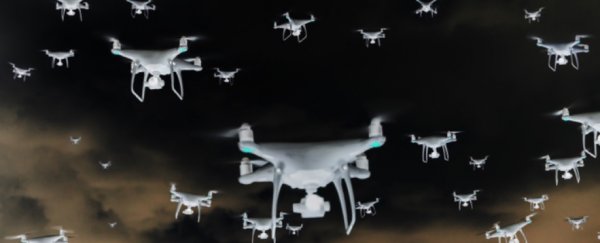Ever since technological advancements made drones possible, people have warned of the potential dangers of weaponised UAVs (unmanned aerial vehicles), which could effectively become murderous slaughterbots we need to defend ourselves against.
Now, it looks like those fears have become a reality. The Russian Ministry of Defence claims its forces in Syria were attacked a week ago by a swarm of home-made drones – the first time such a coordinated assault has been reported in a military action.
According to the Ministry of Defence, Russian forces at the Khmeimim air base and Tartus naval facility "successfully warded off a terrorist attack with massive application of unmanned aerial vehicles (UAVs)" last Friday night.
 Russian Ministry of Defence
Russian Ministry of Defence
"As evening fell, the Russia air defence forces detected 13 unidentified small-size air targets at a significant distance approaching the Russian military bases," the Ministry said in a statement.
"Ten assault drones were approaching the Khmeimim air base, and another three – the CSS point in Tartus."
Six of the assault force drones were intercepted by Russian electronic warfare units, with three of the UAVs being brought to land outside the base, while the remaining three exploded on contact with the ground.
Another seven drones were "eliminated" by Pantsir-S anti-aircraft missiles fired by the Russians, with the bases reporting no casualties or damage, the statement explains.
If the report is accurate, the Russian forces are lucky the attack wasn't worse, because whoever unleashed these drones wasn't fooling around.
While photographs of the improvised UAVs used in the assault make the drones look clunky and strung together, the Russians' analysis reveals they were armed with explosives and launched from a site more than 50 kilometres (31 miles) distant from their targets, navigating the trek via GPS and altitude-control sensors.
The Ministry says a technical examination indicates these drones would have an effective attacking range of about 100 kilometres (62 miles) – which is pretty terrifying – and means that in the new era of UAV warfare, locations that once may have seemed immune to attack, are in fact exposed.
"They thought the base was secure, but now it seems it is vulnerable," Maxim Suchkov of the Russian International Affairs Council told The Washington Post.
 Russian Ministry of Defence
Russian Ministry of Defence
It's unknown who launched the swarm, with the attack being unclaimed at present. But the Russians have hinted that the technology used was too advanced for local militants, seen as a suggestion it could have been supplied by US forces in the vicinity – something the Pentagon says is "absolutely false".
There's an awful lot about this incident that's unconfirmed right now, but one thing we can be sure of is this technological first could usher warfare into a terrifying new chapter – and towards a grim future scientists have been desperately warning we need to prevent.
"Who knows how accurate some of these details really are, but if the number of drones launched at the facility is anywhere near correct, it would seem to be the first self-contained, large scale, coordinated, standoff drone assault on a fixed installation like this," Tyler Rogoway reports at The Drive.
"It seems that the age of drone swarms has arrived, and that's a terrifying reality to comprehend."
